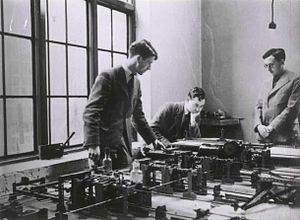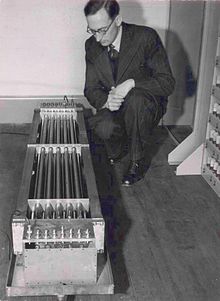- Maurice Wilkes
-
Maurice Wilkes 
Born 26 June 1913
Dudley, Worcestershire, England, UKDied 29 November 2010 (aged 97)
Cambridge, Cambridgeshire, England, UKNationality British Fields Computer Science Institutions Telecommunications Research Establishment
University of Cambridge Mathematical Laboratory
British Computer Society
Digital Equipment CorporationAlma mater St John's College, Cambridge Doctoral students Michael Kay Known for Microprogramming Notable awards Turing Award (1967)
Faraday Medal (1981)
Mountbatten Medal (1997)Sir Maurice Vincent Wilkes FRS, FREng, DFBCS (26 June 1913 – 29 November 2010)[1] was a British computer scientist credited with several important developments in computing. At the time of his death, Wilkes was an Emeritus Professor of the University of Cambridge. He received a number of distinctions: he was a knight bachelor, Distinguished Fellow of the British Computer Society, a Fellow of the Royal Academy of Engineering and a Fellow of the Royal Society.
Contents
Early life, education, and military service
Wilkes was born in Dudley, Worcestershire, England[2] and grew up in Stourbridge, West Midlands, England, where his father worked on the estate of the Earl of Dudley. He was educated at King Edward VI College, Stourbridge and during his school years he was introduced to amateur radio by his chemistry teacher.[3]
 Maurice Wilkes (right) with the Meccano differential analyser in the Cambridge University Mathematics Laboratory, c1937. A.F. Devonshire (left) co-authored a number of papers on melting and disorder with the Laboratory's first director, John Lennard-Jones. The winner of the 1937 Mayhew Prize, J. Corner, is operating the input table (centre).
Maurice Wilkes (right) with the Meccano differential analyser in the Cambridge University Mathematics Laboratory, c1937. A.F. Devonshire (left) co-authored a number of papers on melting and disorder with the Laboratory's first director, John Lennard-Jones. The winner of the 1937 Mayhew Prize, J. Corner, is operating the input table (centre).
He went on to read Mathematics at St John's College, Cambridge from 1931-34, continuing to complete a Ph.D. in physics on the topic of radio propagation of very long radio waves in the ionosphere in 1936.[4] He was appointed to a junior faculty position of the University of Cambridge through which he was involved in the establishment of a computing laboratory. He was called up for military service during WWII and worked on radar at the Telecommunications Research Establishment (TRE), and in operational research.[citation needed]
Initiation into electronic computing
In 1945, Wilkes was appointed as the second director of the University of Cambridge Mathematical Laboratory (later known as the Computer Laboratory).[2]
The Cambridge laboratory initially had many different computing devices, including a differential analyser. Wilkes obtained a copy of John von Neumann's prepress description of the EDVAC, a successor to the ENIAC under construction by Presper Eckert and John Mauchly at the Moore School of Electrical Engineering. He had to read it overnight because he had to return it and no photocopy facilities existed. He decided immediately that the document described the logical design of future computing machines, and that he wanted to be involved in the design and construction of such machines. In August 1946 Wilkes travelled by ship to the United States to enroll in the Moore School Lectures, of which he was only able to attend the final two weeks because of various travel delays.[citation needed]
EDSAC
Since his laboratory had its own funding, he was immediately able to start work on a small practical machine, the EDSAC, once back at Cambridge. He decided that his mandate was not to invent a better computer, but simply to make one available to the university. Therefore his approach was relentlessly practical. He used only proven methods for constructing each part of the computer. The resulting computer was slower and smaller than other planned contemporary computers. However, his laboratory's computer was the first practical stored program computer to be completed, and operated successfully from May 1949.
Other computing developments
In 1951, he developed the concept of microprogramming from the realisation that the Central Processing Unit of a computer could be controlled by a miniature, highly specialised computer program in high-speed ROM. This concept greatly simplified CPU development. Microprogramming was first described at the Manchester University Computer Inaugural Conference in 1951, then published in expanded form in IEEE Spectrum in 1955. This concept was implemented for the first time[5] in EDSAC 2, which also used multiple identical "bit slices" to simplify design. Interchangeable, replaceable tube assemblies were used for each bit of the processor. The next computer for his laboratory was the Titan, a joint venture with Ferranti Ltd begun in 1963. It eventually supported the UK's first time-sharing system and provided wider access to computing resources in the university, including time-shared graphics systems for mechanical CAD.[citation needed]
A notable design feature of the Titan's operating system was that it provided controlled access based on the identity of the program, as well as or instead of, the identity of the user. It introduced the password encryption system used later by Unix. Its programming system also had an early version control system.[citation needed]
Wilkes is also credited with the idea of symbolic labels, macros, and subroutine libraries. These are fundamental developments that made programming much easier and paved the way for high-level programming languages. Later, Wilkes worked on an early timesharing systems (now termed a multi-user operating system) and distributed computing. Toward the end of the 1960s, Wilkes also became interested in capability-based computing, and the laboratory assembled a unique computer, the Cambridge CAP.[citation needed]
In 1974 Wilkes encountered a Swiss data network (at Hasler AG) that used a ring topology to allocate time on the network. The laboratory initially used a prototype to share peripherals. Eventually, commercial partnerships were formed, and similar technology became widely available in England.[citation needed]
Awards, honours, and leadership positions
In 1956 he was elected a Fellow of the Royal Society.
He was a founder member of the British Computer Society (BCS) and its first president (1957–1960). Wilkes received the Turing Award in 1967, with the following citation: "Professor Wilkes is best known as the builder and designer of the EDSAC, the first computer with an internally stored program. Built in 1949, the EDSAC used a mercury delay line memory. He is also known as the author, with Wheeler and Gill, of a volume on Preparation of Programs for Electronic Digital Computers in 1951, in which program libraries were effectively introduced." In 1968 he received the Harry H. Goode Memorial Award, with the following citation: "For his many original achievements in the computer field, both in engineering and software, and for his contributions to the growth of professional society activities and to international cooperation among computer professionals."[citation needed]
In 1980 he retired from his professorships and post as the head of the laboratory and joined the central engineering staff of Digital Equipment Corporation in Maynard, Massachusetts.[2]
He was awarded the Faraday Medal by the Institution of Electrical Engineers in 1981. The Maurice Wilkes Award, awarded annually for an outstanding contribution to computer architecture made by a young computer scientist or engineer, is named after him. In 1986, he returned to England, and became a member of Olivetti's Research Strategy Board. In 1993 Wilkes was presented, by Cambridge University, an honorary Doctor of Science degree. In 1994 he was inducted as a Fellow of the Association for Computing Machinery. He was awarded the Mountbatten Medal in 1997. He was knighted in the 2000 New Year Honours List. In 2001, he was inducted as a Fellow of the Computer History Museum. In 2002, Wilkes moved back to the Computer Laboratory, University of Cambridge, as an Emeritus Professor.[2]
In his memoirs Wilkes wrote:
It was on one of my journeys between the EDSAC room and the punching equipment that 'hesitating at the angles of stairs' the realization came over me with full force that a good part of the remainder of my life was going to be spent finding errors in my own programs.
References
- ^ "Father of British computing Sir Maurice Wilkes dies". BBC News. 30 November 2010. http://www.bbc.co.uk/news/technology-11875821. Retrieved 18 January 2011.
- ^ a b c d "CV for Maurice V. Wilkes". University of Cambridge. http://www.cl.cam.ac.uk/~mvw1/cv-2.pdf. Retrieved 18 January 2011.
- ^ "Professor Sir Maurice Wilkes". The Daily Telegraph. 30 November 2010. http://www.telegraph.co.uk/news/obituaries/technology-obituaries/8171435/Professor-Sir-Maurice-Wilkes.html. Retrieved 18 January 2011.
- ^ "Maurice V. Wilkes - Short Biography". cl.cam.ac.uk. http://www.cl.cam.ac.uk/~mvw1/short-biography.html. Retrieved 30 November 2010.
- ^ "Edsac 2". portal.acm.org. http://portal.acm.org/citation.cfm?id=612476. Retrieved 30 November 2010.
Publications
- The Preparation of Programs for an Electronic Digital Computer by Maurice Wilkes, David Wheeler, and Stanley Gill; (original 1951); reprinted with new introduction by Martin Campbell-Kelly; 198 pp.; illus; biblio; bios; index; ISBN 0-262-23118-2. Available through Charles Babbage Institute
- Automatic Digital Computers. John Wiley & Sons, New York, 1956, 305 pages, QA76.W5 1956.
- A Short Introduction to Numerical Analysis. Cambridge University Press, 1966, reprinted 1971. ISBN 0-521-09412-7 paperback; ISBN 0-521-06806-1 clothbound.
- Time-sharing Computer Systems. Elsevier, 1975. ISBN 0-444-19525-4
- Memoirs of a Computer Pioneer. The MIT Press. 1985. ISBN 0-262-23122-0
External links
- List of papers
- Home page
- Biography of Maurice Wilkes
- Computer Laboratory, University of Cambridge
- Obituary in The Guardian
- Obituary in The Independent
- Obituary in The Telegraph
- Oral history interview with David J. Wheeler, Charles Babbage Institute, University of Minnesota. Wheeler was a research student under Wilkes at the University Mathematical Laboratory at Cambridge from 1948–51. Wheeler discusses the EDSAC project, the influence of EDSAC on the ILLIAC, the ORDVAC, and the IBM 701 computers, as well as visits to Cambridge by Douglas Hartree, Nelson Blackman (of ONR), Peter Naur, Aad van Wijngarden, Arthur van der Poel, Friedrich Bauer, and Louis Couffignal.
- Listen to an oral history interview with Maurice Wilkes - recorded in June 2010 for An Oral History of British Science at the British Library
Categories:- 1913 births
- 2010 deaths
- People from Dudley
- Alumni of St John's College, Cambridge
- Members of the University of Cambridge Computer Laboratory
- British computer scientists
- Computer pioneers
- Computer designers
- DEC people
- English physicists
- Fellows of the Royal Academy of Engineering
- Fellows of the Royal Society
- Turing Award laureates
- Members of the United States National Academy of Sciences
- Fellows of the British Computer Society
- Fellows of the Association for Computing Machinery
- Knights Bachelor
- Presidents of the British Computer Society
Wikimedia Foundation. 2010.

